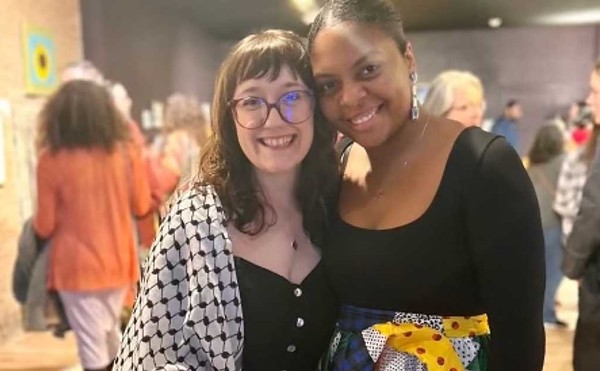When you shop at DeVries Cheese in Eastern Market on a Saturday morning, you might have a bit of a wait, or attempt careful maneuvering, to get in. The shop is almost always packed with happy customers all jockeying for a place at the cheese counter, or for a delicious sample. If you're brave, you might make your way to the back of the store, and take the elevator or stairs to the third floor, where you can shop for more unique Michigan gift items, from baskets to books to bathroom accessories.
If you're lucky, you may notice a door on that floor. Behind it, studios, teeming with music and art, sometimes open to the public, who are beckoned in with live music.
John Osler is the painter whose studio is back there, overlooking Eastern Market through huge, bright windows.
Osler got his start in Detroit as an illustrator back in the late 1950s and 1960s. Detroit, he says, was home to some of the greatest illustrators of the time, including Bernie Fuchs and Mark English, all flocking here to work for the auto industry, illustrating cars and people with them. As time went on, photography took over from illustration, so Osler started working with photography studios, eventually starting his own. Then, 24 years ago, against a backdrop of an emptying, criminal, deteriorating city, he quit, because, he says, "there was no satisfaction."
Osler then began a journey, one that took him to Jonestown, Mississippi, which was an all black town. He went down there for the blues, but found something deeper in the churches, where he would paint, and the people took him in. "It was an emotional time for me, because I was so used to business where you look at somebody and the honesty wasn't there — everybody was in business." In Jonestown, says Osler, "It wasn't about money; it was about who they were."
Osler continued his travels, exploring the South of France and New Orleans, but says he's never left Detroit. "I'm a Detroiter. There's something about Detroit that gets into you, so I'll always be a Detroiter."
The first thing that struck us about Osler's work is that it is almost entirely comprised of African Americans. We ask Osler, an older white man, about this, and he laughs and comments "Well, they're the ones with color! They're colorful! It wasn't deliberate; it was just that they're more full of life. They were the people who got me into painting, the richness of their spirit inside. I see a lot here now; that's why I want to do large things of the people who are the real heroes of Detroit: the grandmas, the mothers who are so solid and strong. I'm white, so everybody asks me that question and people don't buy my art because it's African Americans. African Americans like my art, but I'm not black and they buy black art. It wasn't intentional; I've done others, but it's just the people who influence me. I've never painted my family, which is interesting. I've done little sculptures and things, but I've never painted them. I guess they've never wanted me to.
"Growing up in Birmingham in the '50s, it was an extremely racist community, anti-Semitic," he continues. "I think we're better today than the '50s. I saw a certain appeal in the other that I didn't know anything about or was not allowed to know anything about. When I finally got more involved with the people and how open they were, they taught me lessons. When I went into churches, I was the white guy in the back of the church, like I was at jazz places in Detroit, but they were also so nice to me. They'd say, 'We know what it is not to be loved, so we're going to love.' So, that's why I'm trying to paint, I guess. That was my story."
Osler also "saw dignity ... saw people who worked hard for a long time in their life."
He says "the older folks couldn't look me in the eye, because they weren't used to looking white people in the eye. They couldn't, because it wasn't part of their culture. They lived their whole life not making eye contact with white people. It was that [way] in the South. But when I put the camera up, they would look in the camera because it wasn't me. So I have pictures of them looking at me, but I have to paint them the way they were. But these are people that 15 years ago, 20 years ago were in their eighties, so it was a different time. It's changed now."
Osler pulls paintings out for us to photograph, and tells how he's starting to paint much larger pieces. He points out the beauty of the walls in the old building, the wainscoting of a time long past.
Osler says that when it comes to what is important, in spirit and life, he is rich. You can see the appreciation in his eyes as he talks, and that wealth of gratitude in his art.
John Osler has published two books of his art, John Osler Fine Art and Detroit Jazz. Learn more about the artist and see his work at JohnOsler.com





